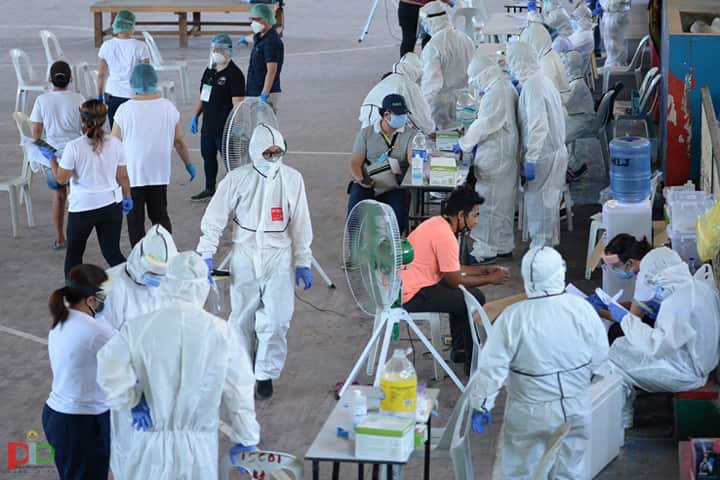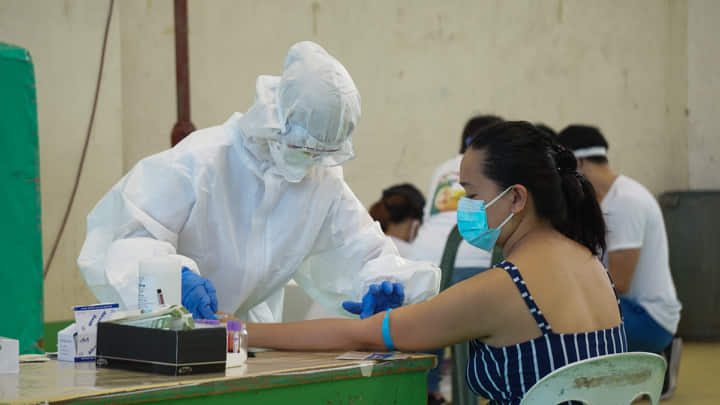Cebu COVID-19 cases near level of hard-hit Metro Manila cities

MASS TESTING Health personnel conduct mass testing at the barangay level in Cebu City amid the rise of cases in at least four urban poor communities in the city. —CEBU CITY PUBLIC INFORMATION OFFICE PHOTO
CEBU CITY—The number of cases of the new coronavirus disease (COVID-19) in this city has risen fast in densely populated barangays that may be difficult to contain if they spread outside of these villages, a health official here warned.
Data from the Cebu City Health Department (CCHD) showed that 1,318 of the 1,417 cases recorded in the city as of May 8 came from the crowded urban poor villages of Mambaling (550), Luz (193), Suba (128) and Labangon (125) as well as from the Cebu City Jail (322).
On March 30, when there were still 20 COVID-19 cases in the city, CCHD chief Dr. Daisy Villa already sounded the alarm that the virus could potentially spread to urban poor communities. “Once the virus spreads, it would be hard to contain it,” she then warned.
The number of confirmed COVID-19 cases in Cebu City now represents about 88 percent of the 1,606 infections recorded on the entire island of Cebu as of 11 a.m. of Friday, Department of Health (DOH) records showed.
Villa said people living in informal settlements or those in packed communities were at heightened risk of contracting the virus, as isolation was difficult when space was limited and rooms were often shared.
Article continues after this advertisementCebu City Mayor Edgardo Labella has locked down the villages of Luz and Labangon, Sitio Alaska of Mambaling, as well as the fish port and market area in Suba where most of the COVID-19 cases were recorded.
Article continues after this advertisementToo early
On Thursday, Cebu recorded its highest surge of cases at 200 in one day, higher than the 111 new cases recorded in Metro Manila on the same day. The cases in Cebu City, as of Friday, also inched closer to the 1,464 virus cases recorded in Quezon City on Thursday, the hardest hit area in the National Capital Region (NCR). By Friday, however, the number of new cases in Cebu dropped to 28, while the NCR recorded 84 new cases. The country now has a total of 10,463 cases, with 1,734 recoveries and 696 deaths as of Friday.
The DOH said it would be too early to say if Cebu island is now the new epicenter of COVID-19 in the country.
Health Undersecretary Maria Rosario Vergeire pointed out that a “big chunk” of cases in Cebu came from enclosed facilities, like jails, which she called “clusters.”
She also noted that there was not much transmission of SARS-CoV-2, the coronavirus that causes COVID-19, in Cebu communities outside the clusters.
“I don’t think we can say that as of now,” said Vergeire in reply to questions whether Cebu is now the new COVID-19 epicenter in the Philippines.
“We can’t say that now because it is only for a few days that we see increases in cases,” she said, speaking in Filipino at an online press conference on Friday.
“Second, we see that the increase comes from closed institutions. Mainly, the increase of cases in Cebu was because of different jails which had outbreaks,” she added in Filipino.

DRAWING BLOOD Scene from the rapid mass testing being conducted at the Vicente Sotto Memorial Gym in Barangay Punta Princesa, Cebu City, on Friday. —Gerard Francisco/CEBU DAILY NEWS Digital
Health protocols
Labella appealed to Cebuanos to assist in the city government’s fight against the spread of the virus by cooperating and adhering to the health protocols being implemented in the city.
Starting May 6, a strategic mass testing was implemented in the cities of Cebu, Mandaue, and Lapu-Lapu to determine the next steps authorities needed to take in the fight against COVID-19.
The three cities, where the bulk of the working population on the island is found, may transition from enhanced community quarantine to general community quarantine on May 21, depending on the results of the mass testing.
“It’s painful to listen to what has been going on now in the city but we need to know the extent of the [spread of the] virus. I request our people to bear with us and to continue staying at home,” Labella said on Friday.
Dr. Jaime Bernadas, director of the DOH in Central Visayas, said they were expecting the number of COVID-19 cases in Cebu to still rise due to the mass testing being conducted.
“When we do this (mass testing), we should expect a rise in positive cases given that the virus is highly transmissible,” he said. “We fear that possibility but it should not be a cause for panic. Knowing our status is a step toward a solution and is way better than fighting this disease blindly,” he added. —WITH REPORTS FROM INQUIRER.NET